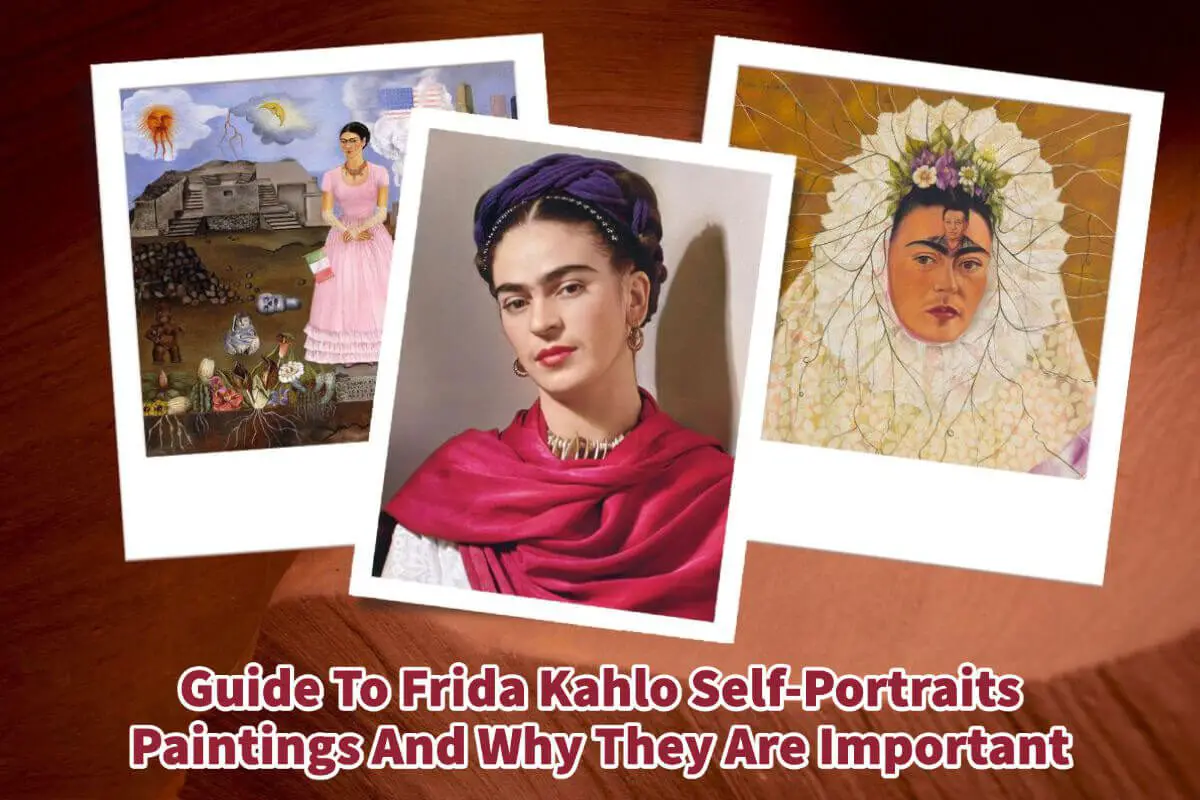Frida Kahlo is one of the most prominent Mexican painters whose works have shaped modern culture and inspired many worldwide. Her self-portraits, in particular, offer a unique insight into her innermost thoughts, emotions, and life experiences.
Frida Kahlo’s self-portraits give us a unique look and understanding of her life, suffering, resilience, and inner strength. The self-portraits show her physical and psychological torture. Frida Kahlo’’s self-portraits created both powerful and beautiful artworks. Frida Kahlo and her self-portraits left us with a timeless legacy of strength and courage.
Table of Contents
- Why Did Frida Kahlo Paint So Many Self-Portraits?
- Friday Kahlo’s Paintings Are Filled With Symbolism
- Frida Kahlo’s Self-portraits Helped Her To Understand Her Own Identity And Life Experiences
- Frida Kahlo’s Self-Portraits Explored Her Unique Life
- Frida Kahlo’s Self-Portraits Contest Society’s Beauty Standards
- Frida Kahlo’s Self-Portraits Are More Than A Reflection In The Mirror
- Frida Kahlo’s Self-Portraits Inspire Us To Create Our Life Narratives
- 10 Of Frida Kahlo’s Most Important Self-Portrait Paintings
- Self-Portrait With Thorn Necklace And Hummingbird, 1940 By Frida Kahlo
- Self-Portrait Dedicated To Dr. Eloesser, 1940 By Frida Kahlo
- Self-Portrait With Monkeys, 1943 By Frida Kahlo
- The Two Fridas,1939, By Frida Kahlo
- Self-Portrait With Necklace, 1933 By Frida Kahlo
- Self-Portrait On The Borderline Between Mexico And The United States, 1932 By Frida Kahlo
- Self-Portrait With Braid, 1941, By Frida Kahlo
- Roots, 1943 By Frida Kahlo
- Self-Portrait As A Tehuana, 1943 By Frida Kahlo
- Self-Portrait With Cropped Hair, 1940, By Frida Kahlo
- Frequently Asked Questions
- Related Questions
Why Did Frida Kahlo Paint So Many Self-Portraits?

Frida Kahlo is renowned for her many self-portraits, which were deeply personal and often included imagery of suffering. Self-portraits gave Frida a way to express her feelings that she could not find elsewhere.
Friday Kahlo’s Paintings Are Filled With Symbolism
Frida Kahlo is unique because her paintings are filled with symbols representing her life and experiences, such as monkeys to symbolize the pain of childbirth and birds to symbolize freedom.
She also used religious symbols such as Madonna holding her animal babies or signs of the martyred Christ.
Frida Kahlo’s Self-portraits Helped Her To Understand Her Own Identity And Life Experiences
Frida’s self-portraits were also a way for her to come to terms with and understand her own identity. The artist had several life-altering experiences, such as a bus accident that left her permanently disabled and her mother’s death when she was only 13 years old.
Frida Kahlo explores her identity and life experience without reservations. She did not hold back but dwelled deep into her inner self and soul. She has left us with a timeless legacy of strength, courage, and resilience through her self-portraits.
Frida Kahlo’s Self-Portraits Explored Her Unique Life
Frida Kahlo painted these self-portraits as she worked to explore and make sense of her unique life circumstances and her relationships with her family, friends, and lovers.
At the heart of many of these life experiences and self-portraits, she explores female sexuality, pain, illness, and passion.
Frida Kahlo’s Self-Portraits Contest Society’s Beauty Standards
Frida’s self-portraits allowed her to combat society’s beauty standards. Due to the bus accident mentioned above, she had a curvature of the spine that made it difficult for her to sit straight. But instead of conforming to the standard of beauty at the time, Frida embraced her body and used it as a form of self-expression in her paintings.
She was someone who contested the female beauty standards of the time and what people considered to be beautiful.
Frida Kahlo’s Self-Portraits Are More Than A Reflection In The Mirror
In this way, Frida Kahlo’s self-portraits were much more than just a reflection in the mirror; they were an opportunity for her to grapple with her identity, experiences, and emotions. She created a powerful narrative about herself through her paintings and inspired countless others to do the same.
This is because Frida Kahlo was not afraid to look deep into the mirror of self-reflection and explore many of society’s taboo themes.
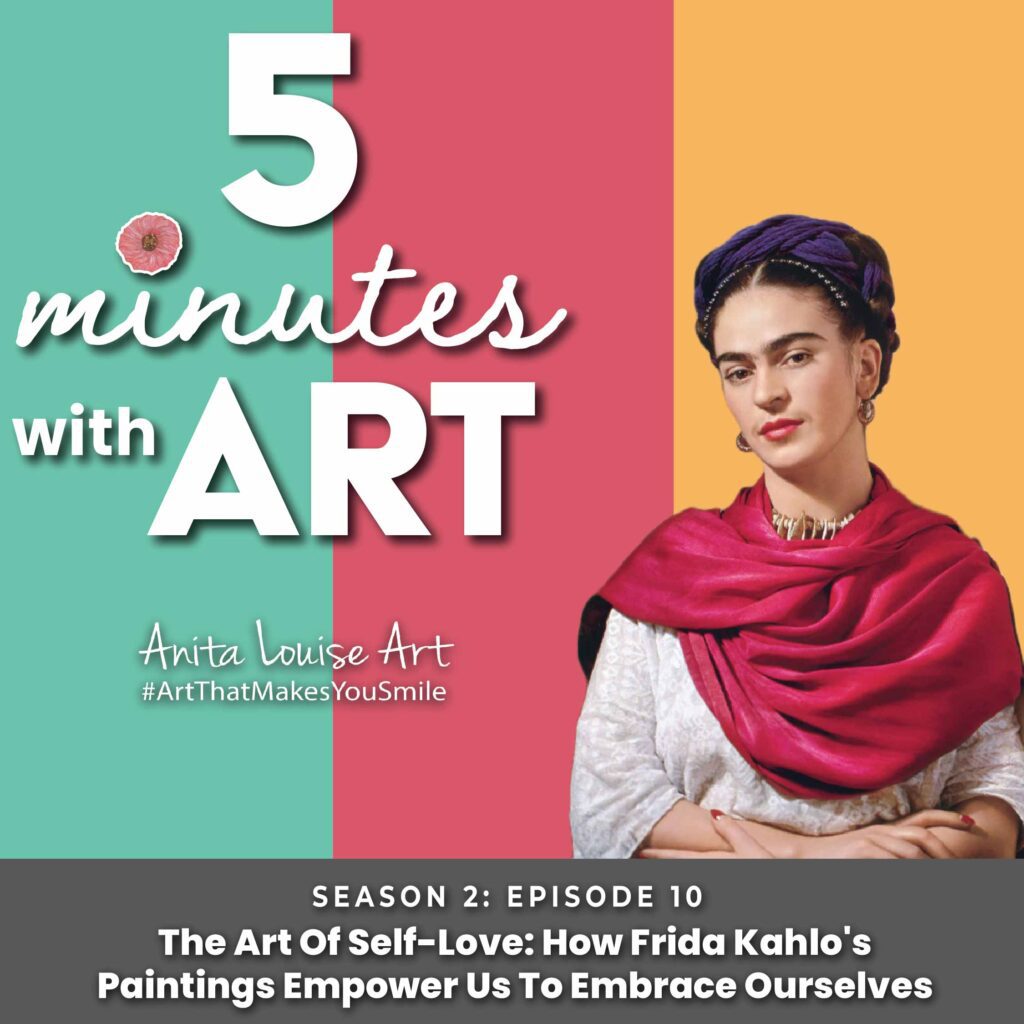
Listen To Our Podcast About The Art Of Self-Love: How Frida Kahlo’s Paintings Empower Us To Embrace Ourselves by clicking here.
Frida Kahlo’s Self-Portraits Inspire Us To Create Our Life Narratives
Frida Kahlo painted so many important self-portraits. Her artwork gives us a unique insight into her life and experiences and shows how art can be used to explore our identity and emotions. She inspires us to create our powerful narratives.
Frida Kahlo said this in his own words about her self-portraits:
“I paint myself because I am so often alone and because I am the subject I know best.”
Frida Kahlo
10 Of Frida Kahlo’s Most Important Self-Portrait Paintings
The iconic Mexican artist Frida Kahlo is internationally renowned for her groundbreaking self-portraits demonstrating her unique approach. Kahlo’s works contain a storied in vivid colors and emotional depth.
These captivating self-portraits give the viewer an authentic understanding of Kahlo’s life—her relationship to her identity, heritage, joy, pain, and suffering. To honor the memory of this remarkable artist, present ten (of many) of Frida Kahlo’s most essential self-portraits.
Self-Portrait With Thorn Necklace And Hummingbird, 1940 By Frida Kahlo
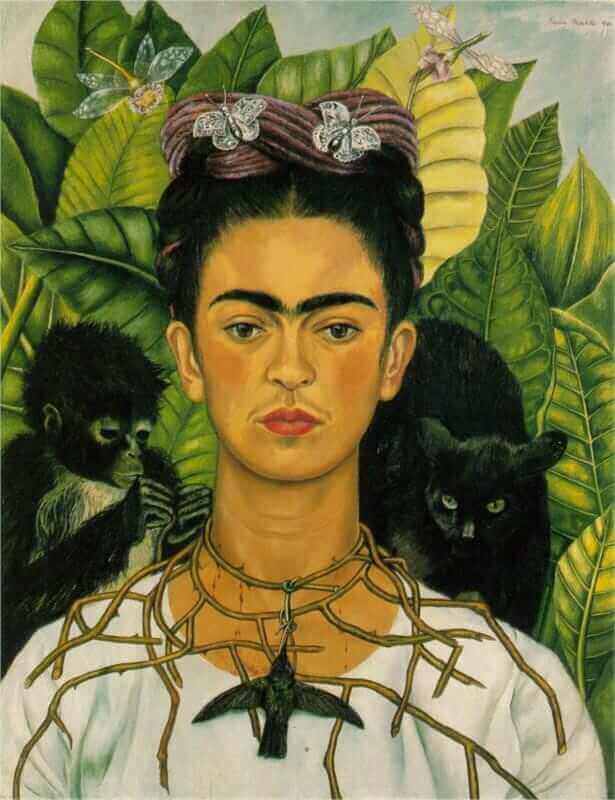
Self-Portrait with Thorn Necklace and Hummingbird, the painting features the artist wearing a distinctive necklace of thorns, symbolizing her ill-fated relationship with fellow Mexican painter Diego Rivera. The hummingbird hovering above her head is a sign of hope amid anguish.
Self-Portrait Dedicated To Dr. Eloesser, 1940 By Frida Kahlo

Self-Portrait Dedicated To Dr. Eloesser, the painting was inspired by a visit that Frida Kahlo made to San Francisco to seek treatment from the doctor who had previously operated on her spine. The purple and flowers in the background symbolize recovery and hope for the future.
Self-Portrait With Monkeys, 1943 By Frida Kahlo
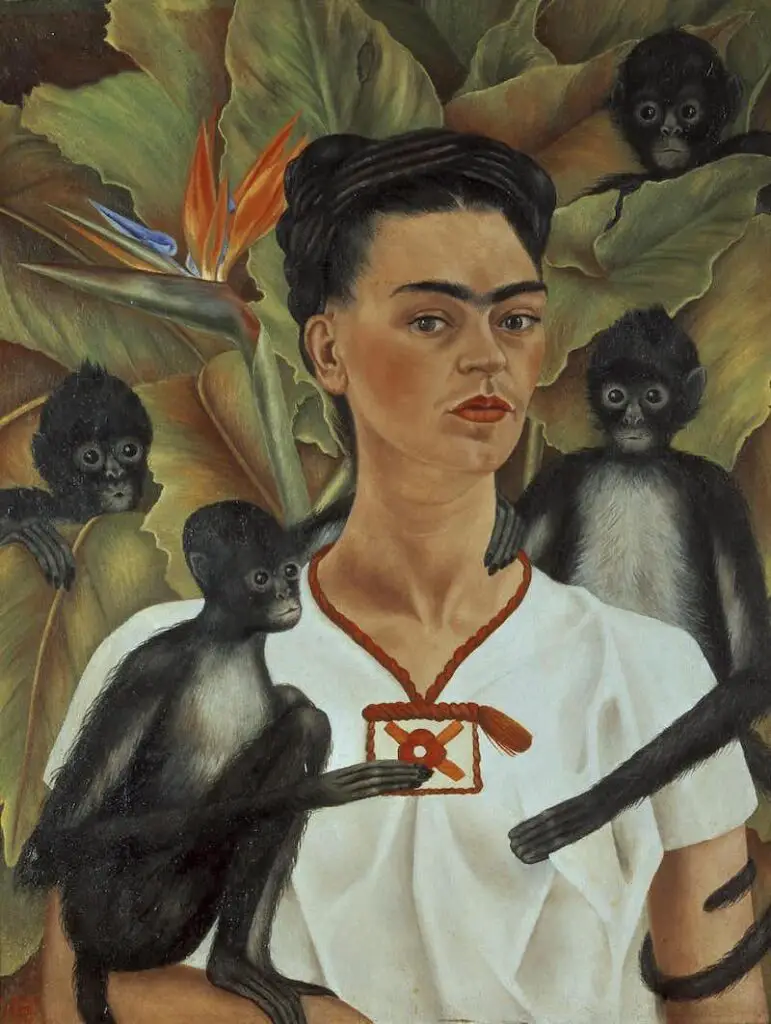
Self-Portrait with Monkeys shows how Frida Kahlo often included animals in her paintings, and this painting features monkeys surrounding her. This can be seen as a representation of her loneliness and a reflection of her wildness and passion for life.
The Two Fridas,1939, By Frida Kahlo
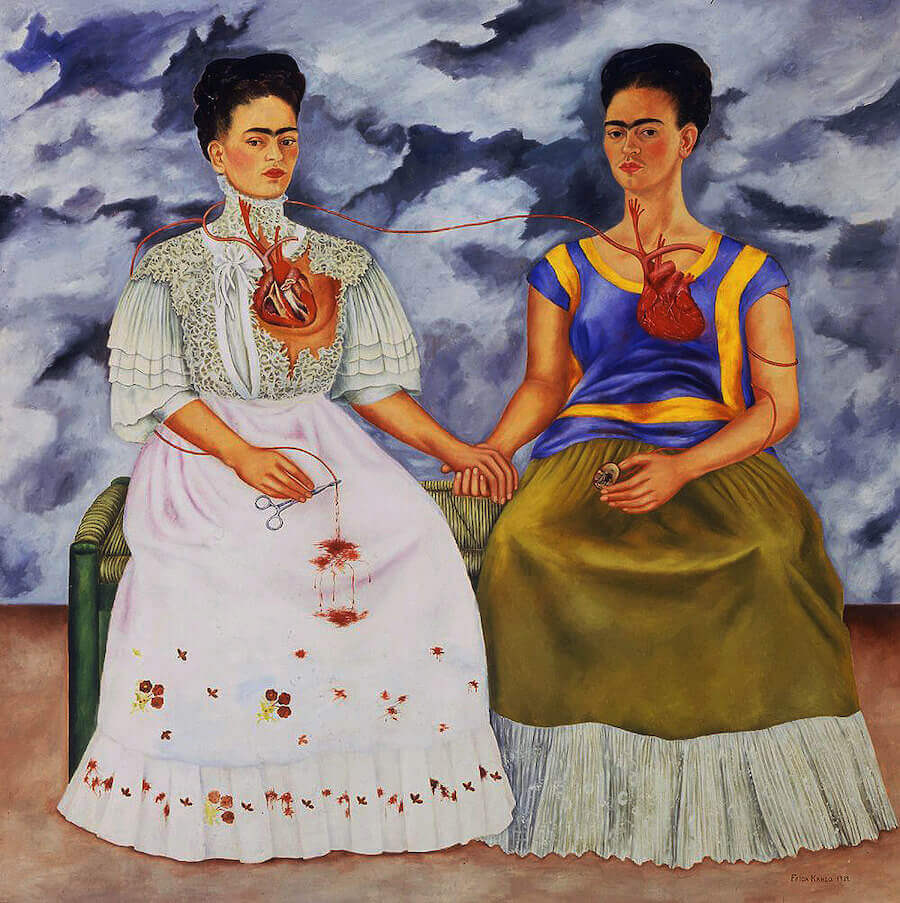
The Two Fridas is a double portrait of the artist who was painted shortly after her divorce from Diego Rivera. It shows two different versions of Frida – one in a traditional Tehuana dress and the other wearing a European-style dress – reflecting her inner conflict between tradition and modernity and her own culture and western culture.
In both of these self-portraits, we see her heart exposed to symbolize that her heart was also broken.
Self-Portrait With Necklace, 1933 By Frida Kahlo
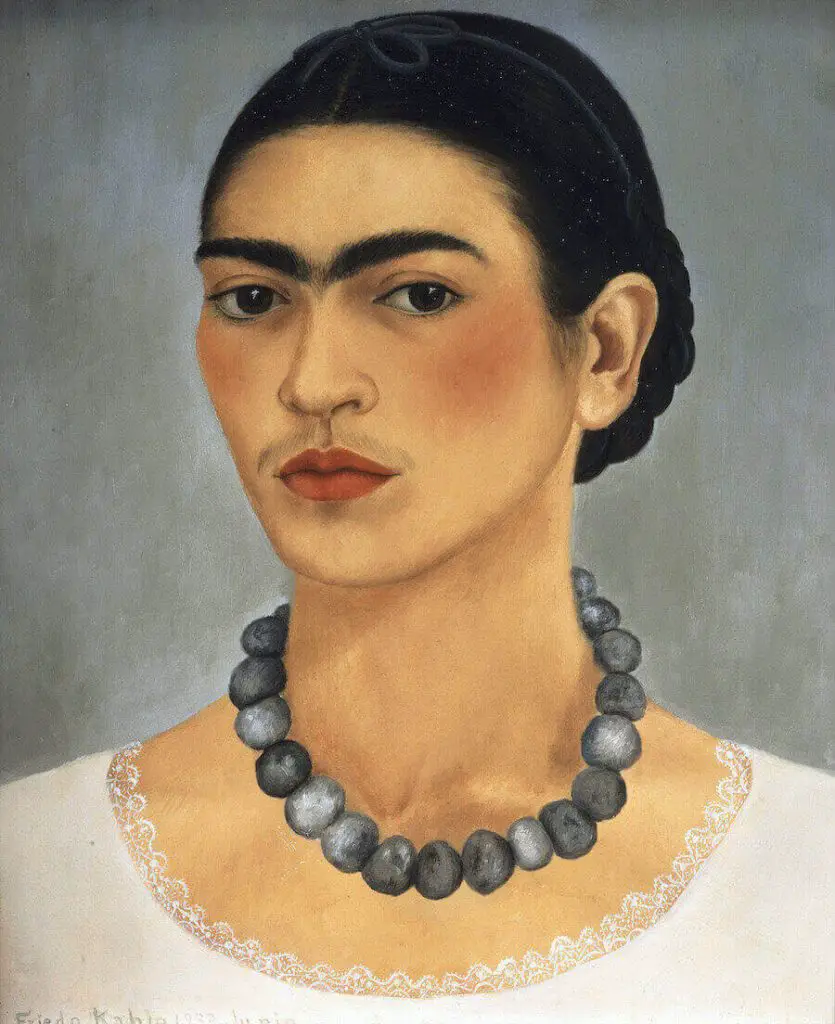
Self-Portrait with Necklace, Frida Kahlo painted this work shortly after her marriage to Diego Rivera. The necklace in the painting references their union and serves as a symbol of Kahlo’s strength and resilience.
Self-Portrait On The Borderline Between Mexico And The United States, 1932 By Frida Kahlo
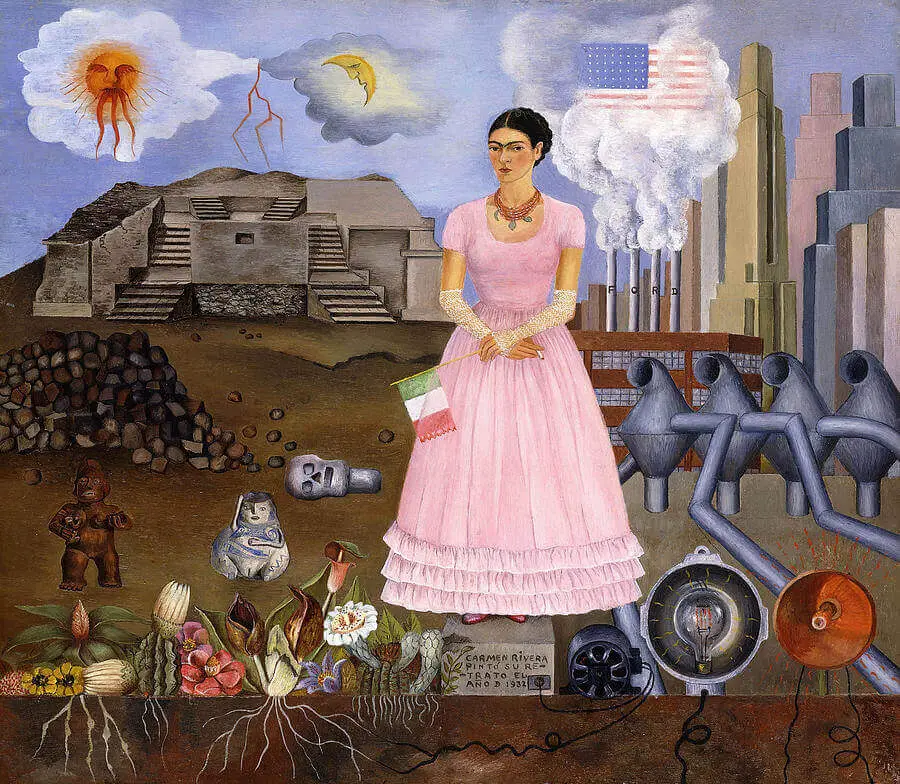
Self-Portrait on the Borderline between Mexico and the United States (1932): This painting is considered one of Kahlo’s earliest self-portraits and shows her standing between two countries – Mexico and the United States.
This is seen as a representation of Kahlo’s bi-cultural identity and her experience of living in both countries.
Self-Portrait With Braid, 1941, By Frida Kahlo
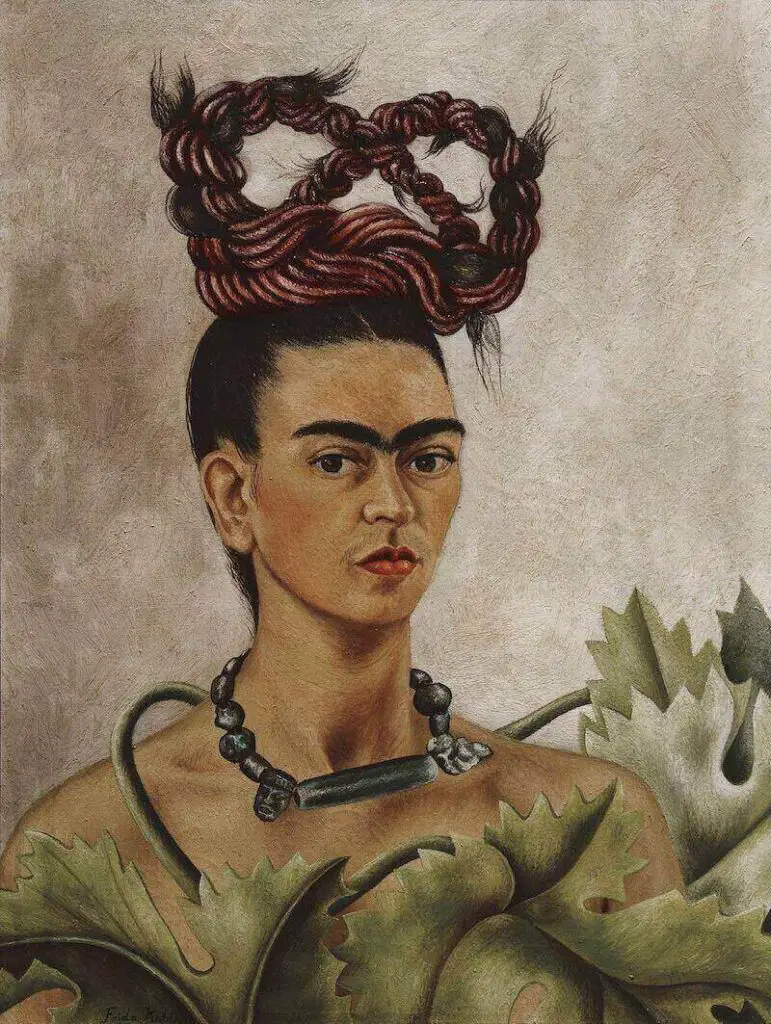
Self-Portrait with Braid is a painting created shortly after Frida Kahlo’s divorce from Diego Rivera, and it features the artist wearing her long braid. It is seen as a representation of Kahlo’s strength and independence, showing her ability to endure despite her life’s pain.
Roots, 1943 By Frida Kahlo

The Roots painting was created during Frida Kahlo’s return to Mexico. It shows the artist with her feet planted firmly in roots, reflecting her strong connection to her culture and homeland of Mexico.
Self-Portrait As A Tehuana, 1943 By Frida Kahlo
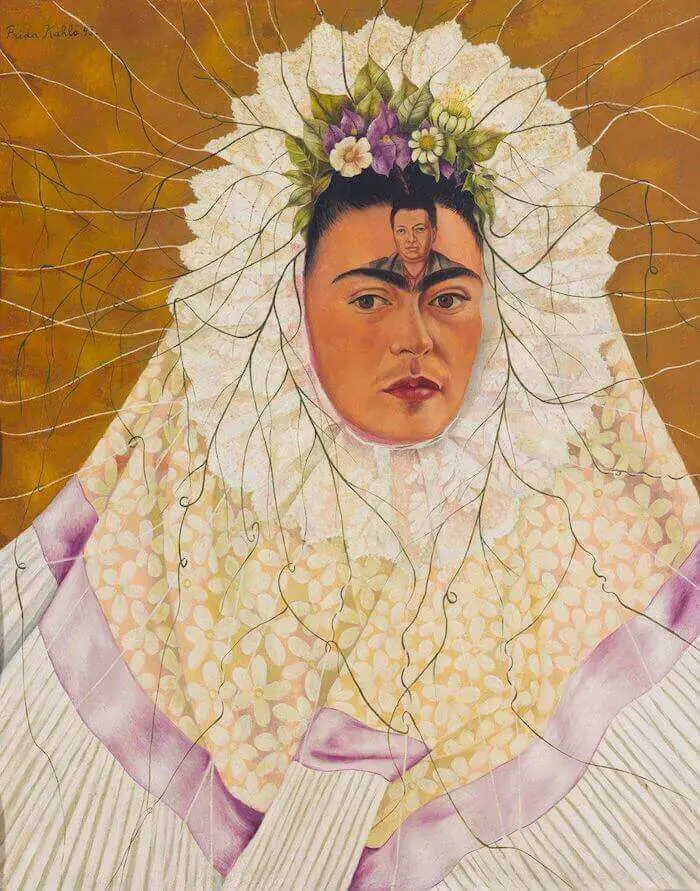
Self-Portrait as a Tehuana is a painting created during Kahlo’s second trip to Mexico from the United States and shows the artist wearing a traditional Tehuana dress. It is seen as an expression of her pride n her can heritage and a reflection of her fierce independence.
On the forehead is a painting of Diego Rivera. This painting is also known as “Diego In My Thoughts” and “Thinking of Diego.” It shows she wanted to possess Diego Rivera and was hurt by his many affairs with other women.
Self-Portrait With Cropped Hair, 1940, By Frida Kahlo
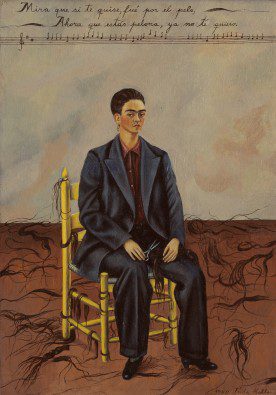
Self-Portrait with Cropped Hair is a painting created shortly after Frida Kahlo’s divorce from Diego Rivera, and it shows the artist has cut off her long braid in a gesture of defiance. It is a symbol of her freedom and liberation and an expression of her pain, anguish, and isolation.
These ten self-portraits are just a few examples of Frida Kahlo’s incredible artwork that has inspired people worldwide. Her boldness, courage, and unique vision are celebrated in art.
From her physical and psychological suffering, Kahlo ultimately created a body of work that is both powerful and beautiful. Her self-portraits have left us with a timeless legacy of strength and courage.
By capturing her story through these self-portraits, she has reminded us of our strength and resilience in facing trials.
Anita Louise Art is dedicated to art education, great artists, and inspiring others to find and create their art. We love art that uplifts and inspires. #ArtToMakeYouSmile! #ArtToMakeYouHappy!
If you are interested to see any of my art, you can find out more by clicking here. If you are interested in what inspires me and my paintings, you can discover more by clicking here.
We have a free newsletter and would love you to be part of our community; you can subscribe to the newsletter by clicking here. If you have any questions, I would be happy to talk to you anytime. You can reach me, Anita, by clicking here.
Subscribe to our Anita Louise Art YouTube Channel with great videos and information by clicking here.
Join us for our podcast “5 Minutes With Art.” Spend 5 minutes a week with us to discover and learn about great art and artists. You can find out more about our podcast by clicking here.
Frequently Asked Questions
Who was Frida Kahlo?
Frida Kahlo was a Mexican painter known for her symbolic and emotive self-portraits. She gained fame for her depictions of the female experience and form, combining elements of realism, symbolism, and surrealism.
Why are Frida Kahlo’s self-portraits important?
Kahlo’s self-portraits are important because they are a deeply personal exploration of identity, suffering, gender, post-colonialism, and the human condition. Her work has had a significant influence on feminist art and symbolism.
What are some of the most famous self-portraits by Frida Kahlo?
Some of her most famous self-portraits include “The Two Fridas,” “Self-Portrait with Thorn Necklace and Hummingbird,” and “The Broken Column.”
How many self-portraits did Frida Kahlo paint?
Of her around 200 paintings, 55 are self-portraits. These works often reflect her physical and emotional pain.
Why did Frida Kahlo paint so many self-portraits?
Kahlo once said, “I paint myself because I am so often alone and because I am the subject I know best.” Her self-portraits are a form of self-expression and exploration, dealing with her identity, her physical and emotional suffering, and her relationships.
How did Frida Kahlo’s life experiences influence her self-portraits?
Kahlo’s self-portraits were significantly influenced by her life experiences, including her debilitating bus accident, her tumultuous marriage to Diego Rivera, and her struggles with infertility. These experiences are often symbolically represented in her paintings.
What is the meaning behind “The Two Fridas”?
“The Two Fridas” is considered a representation of Frida’s dual heritage and identity (European and Mexican), as well as her emotional state during her divorce from Diego Rivera. The two Fridas hold hands, suggesting that they are inseparable despite their differences.
What symbolism can be found in Kahlo’s “Self-Portrait with Thorn Necklace and Hummingbird”?
This painting is filled with symbols: the thorn necklace may represent her physical pain or her painful relationship with Rivera, the dead hummingbird symbolizes bad luck, and the black cat is traditionally a symbol of death or bad luck.
What does “The Broken Column” reveal about Frida Kahlo’s personal struggles?
“The Broken Column” reflects Frida’s physical suffering after her bus accident that left her in constant pain and confined to medical corsets for much of her life. Her spine is replaced by a broken column, showing her fragility and enduring strength.
Related Questions
Why Was Impressionism Art At First Rejected?
During the emergence of impressionism art, fine-art oil painting was an essential addition to the interior design of a home, especially for the affluent and the increasing arrival of the middle classes. For these art patrons, only some art styles were considered acceptable for them to use for the interior design of their home, and impressionism art did not fit into any of these culturally acceptable fine art categories.
By clicking here, you can learn more by reading Why Was Impressionism Art at First Rejected?.
Why Is Van Gogh Considered Such A Great Artist?
Many things make Vincent Van Gogh unique and great as an artist. He had a great way to use color in his art, but more than that, he was an artist who set and paved the way for other artists. He changed art with his brushstroke technique, how he used color, and his design abilities. Van Gogh did all this as a self-taught artist.
By clicking here, you can learn more by reading Why Is Van Gogh Considered Such A Great Artist?.
What Art Tools Did Vincent Van Gogh Use?
Vincent Van Gogh used most of the essential tools that artists of his day used, such as oil paints, turpentine, oil, canvas, brushes, palette knife, and easel. We learn from some of his letters how he used these art tools for his paintings. We also know from the letters how essential these art tools were to him.
By clicking here, you can learn more by reading What Art Tools Did Vincent Van Gogh Use?.

